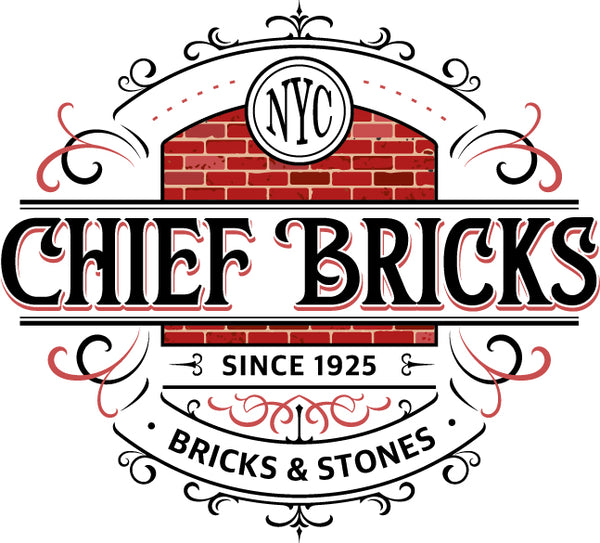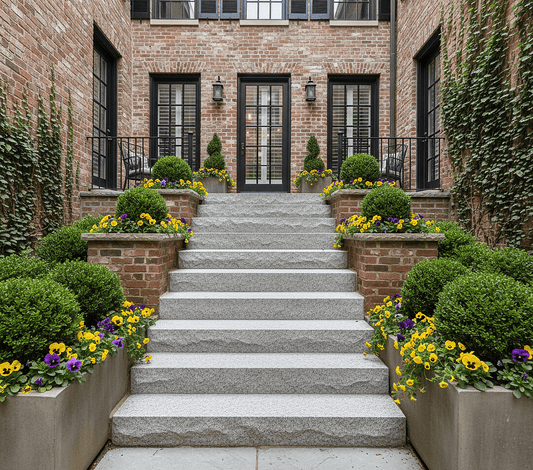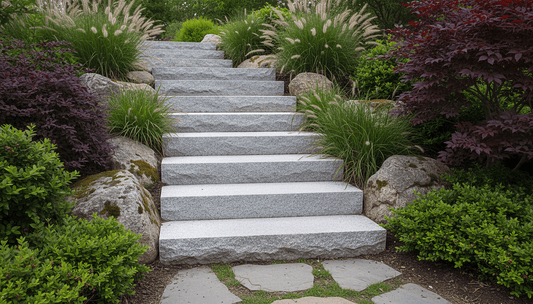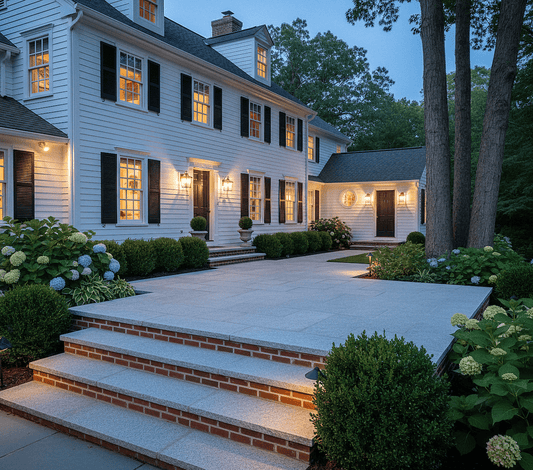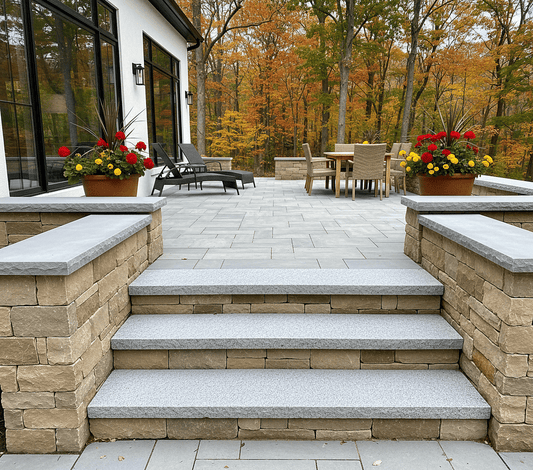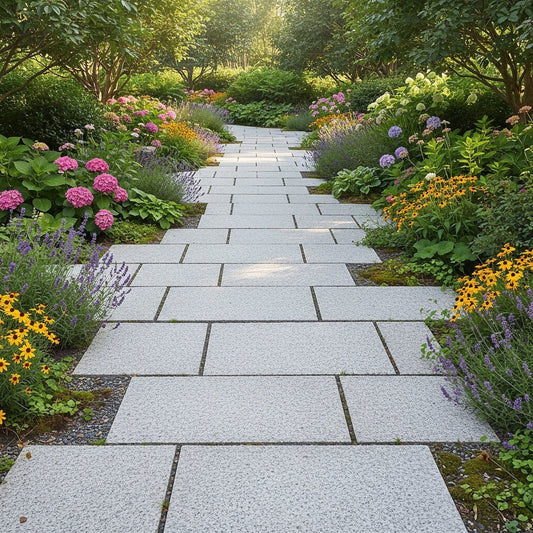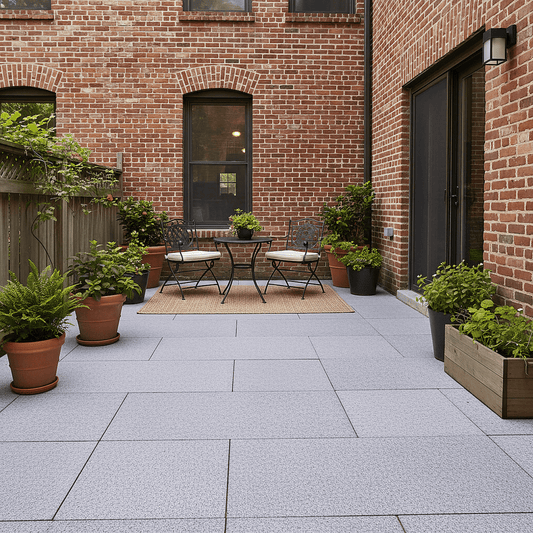Your home's entrance is the first thing people see. It sets the tone for everything inside. You want it to be beautiful, welcoming, and built to last. For many homeowners, this begins with the perfect set of stairs, which is why Granite Steps and Treads are becoming such a popular choice.
You have likely seen concrete steps crack or wooden stairs splinter and rot. These materials just do not hold up over time, especially against harsh weather. Investing in your entryway means choosing a material that will look just as good in twenty years as it does today, making Granite Steps and Treads a fantastic option for any home.
Table of Contents:
- What Exactly Are Granite Steps and Treads?
- Why Granite Is the Best Choice for Outdoor Steps
- Choosing the Right Granite Steps and Treads for Your Home
- How Granite Compares to Other Materials
- Installation Insights You Should Know
- Integrating Granite into Your Complete Landscape Design
- Finding High-Quality Granite Steps and Treads
- Conclusion
What Exactly Are Granite Steps and Treads?
You have probably heard of granite countertops, but this versatile granite natural stone is perfect for the outdoors too. Granite is an igneous rock formed from slowly cooling magma deep within the earth. This slow process allows large, interlocking crystals of quartz, feldspar, and mica to form, giving granite its characteristic speckled appearance and incredible strength.
When we discuss granite stairs, we usually mean one of two products. Solid granite steps are large, thick blocks of stone that create a full, self-supporting staircase. Granite treads, on the other hand, are thinner slabs designed to be placed over an existing structure like a concrete, stone or brick base, offering a simple way to upgrade.
Solid stone steps are ideal for new construction or complete landscape renovations where a durable foundation can be prepared. Treads are excellent for retrofitting old, worn staircases, providing a fresh look without a full demolition. Reclaimed granite is another option, offering a weathered, historic character that new stone cannot replicate.
Why Granite Is the Best Choice for Outdoor Steps
So, what makes granite so great for stairs? It comes down to a few key advantages that other materials cannot match. From durability to aesthetics, granite delivers on all fronts.
Unbeatable Durability and Strength
Granite is one of the hardest natural stones on earth, scoring a 6 to 7 on the Mohs scale of hardness. This means it resists scratches and abrasion from daily foot traffic, dragging furniture, or using shovels in the winter. This is a material that will not easily chip or wear down.
It is also incredibly dense and non-porous, making it highly resistant to water penetration. Granite can handle brutal freeze-thaw cycles without cracking or spalling like concrete often does. It stands up to snow, ice, and de-icing salts, which can destroy lesser materials over just a few seasons.
A Safer Surface in Any Weather
Safety is a primary concern for any outdoor staircase. A wet, slippery surface is a major hazard for your family and guests. Wood can get slick with algae, and many smooth concrete or paver finishes become dangerous when wet or icy.
Most outdoor granite steps and stair treads have a thermal finish, sometimes called a flamed finish. This process exposes the stone to intense heat, causing the surface grains to burst and create a uniform, non-slip texture. The complete step finish thermal treatment gives you confidence and security, even during a rainstorm or after a frost.
Looks Amazing with Almost No Effort
Nobody wants to spend their weekends sanding, staining, and sealing outdoor steps. With granite, this constant maintenance is a thing of the past. Its dense nature means it naturally resists stains from mud, fallen leaves, and other organic debris.
A simple cleaning with a hose or a gentle pressure washer is all it takes to keep them looking new. Unlike wood that needs constant upkeep, granite maintains its natural color and beauty for decades with very little work. Popular options like gray granite or dark gray granite are particularly good at hiding dirt between cleanings.
A Real Boost to Your Home's Value
Strong curb appeal is not just about making your house look nice; it adds real, measurable value. High-quality hardscaping is one of the top features homebuyers look for. Replacing old, worn-out steps with solid granite instantly elevates your home's appearance, improving its entry / curb appeal.
Think of it as a long-term investment in your property. While the initial cost might be higher than wood, granite's longevity and low maintenance mean it costs less over the life of your home. It is a feature that pays for itself in both enjoyment and resale value.
Choosing the Right Granite Steps and Treads for Your Home
Once you decide on granite, you have some enjoyable choices to make. Granite is not a one-size-fits-all product. You can select colors, finishes, and edge styles that perfectly match your home's aesthetic and your personal taste.
Project planning is important at this stage to coordinate the look of your new steps with the rest of your home's exterior. Consider the color of your siding, roofing, and any existing stone or brickwork. Having a clear plan helps all the elements of your outdoor living space work together harmoniously.
Colors and Patterns
The color of your granite is a great way to customize your look. Gray granite is a classic and versatile choice. A salt-and-pepper pattern offers a traditional look that complements almost any style. When selecting, it is a good idea to view samples in natural daylight to see how they look next to your home.
Surface Finishes
The finish is one of the most important choices for outdoor use. As mentioned, a thermal finish is the standard for safety because it provides excellent traction. There are other options, but they are generally not recommended for outdoor stair treads.
| Finish Type | Description | Best Use |
| Thermal / Flamed | A rough, textured surface created by applying high heat. | Outdoor steps, walkways, pool coping. |
| Honed | A smooth, matte finish with no reflection. | Indoor flooring, countertops. Too slippery for outdoor steps. |
| Polished | A glossy, reflective surface that brings out the stone's color. | Indoor countertops, accent walls. Extremely slippery when wet. |
| Bush-Hammered | A textured finish with a pitted appearance, providing good slip resistance. | An alternative to thermal for outdoor surfaces. |
Edge Styles
The edge style also dramatically changes the final look of your stone steps. A rock-faced edge has a rough, split texture that looks very rustic and natural. A straight, sawn edge provides a cleaner, more modern appearance for a contemporary home.
For a softer look, you can opt for a rounded or bullnosed edge. The style you choose should complement the overall design of your home and landscape. Your supplier can show you examples of how each edge profile appears on a finished step.
How Granite Compares to Other Materials
It helps to see a direct comparison to understand why so many people choose granite for their steps. Looking at the lifetime cost and effort involved makes the choice much clearer. Let's break it down against common alternatives.
| Feature | Granite | Poured Concrete | Wood | Composite |
|---|---|---|---|---|
| Durability | Excellent (Lifetime). | Fair (Cracks, Spalls). | Poor (Rots, Warps). | Good (Can fade, scratch). |
| Maintenance | Very Low. | Medium (Sealing, Patching). | High (Staining, Sealing). | Low (Cleaning). |
| Safety | Excellent (Non-slip finish). | Fair (Can be slippery). | Poor (Slippery when wet). | Good (Can be slippery). |
| Lifetime Cost | Low. | Medium. | High (with replacement). | Medium. |
| Appearance | Timeless and Natural. | Utilitarian. | Classic (requires upkeep). | Artificial. |
As you can see, while the upfront cost of granite might be more, it wins easily when you consider how long it lasts and how little work it needs. Materials like concrete block may seem cost-effective initially but lack the refined appearance and long-term durability of solid stone. It is a choice you make once, and it serves you for a lifetime.
Installation Insights You Should Know
Putting in granite steps is not a simple weekend project. A single 4-foot solid granite step can weigh over 500 pounds. This job requires professionals with the right equipment and experience to move and place these heavy pieces safely and correctly.
The most critical part of the installation is the foundation. Steps need a deep, compacted gravel base that extends below the frost line in your region. This prevents the ground from heaving in the winter and making your steps uneven or unstable over time.
A proper base involves:
- Excavating the area to the correct depth.
- Adding and compacting a layer of crushed stone aggregate.
- Placing a layer of clear stone for excellent drainage.
- Ensuring the base is perfectly level before the first step is set.
For treads placed over concrete, the process is a bit different. The installer checks that the existing concrete base is solid, clean, and level. They then use a strong masonry adhesive to permanently bond the granite treads to the structure, giving an old staircase a beautiful new life.
Integrating Granite into Your Complete Landscape Design
Granite steps are often the starting point for a more comprehensive landscape project. To create a truly stunning outdoor living space, consider using granite in other areas. A cohesive design using the same or complementary materials creates a high-end, unified look.
Match your new steps with granite stone pattern pavers for a grand walkway or a beautiful patio. You can choose traditional sizes or opt for large format pavers for a more modern feel. Using granite curbing along driveways and garden beds defines the space and protects your landscaping.
For properties with a slope, a granite retaining wall constructed from durable wall stone can be both functional and beautiful. Topping the wall with matching wall caps gives it a professional, finished appearance. This same stone can be used to build impressive pillars at the end of your driveway, capped with granite pillar caps.
Extend the use of granite to other features that improve your outdoor living experience. Consider adding handsome granite posts for lighting or a sturdy granite mailbox post for unmatched durability. For a complete look, incorporate matching stone veneer on your home's foundation or columns. An estate veneer series can tie the whole design together. You can even add functional art with stone benches or stone bird baths.
Finding High-Quality Granite Steps and Treads
Not all granite is created equal. When you are buying Granite Steps and Treads, quality and consistency are everything. You want steps that have a uniform color, texture, and size, so your finished staircase looks flawless.
Finding the right supplier makes all the difference, especially for large projects. Look for a dealer that sources high-quality granite with consistent properties. A reputable supplier will have a large inventory, allowing you to get the materials you need without long delays.
A good stone yard can also help with project planning tools and expert advice. They can help you coordinate your steps with other hardscaping materials. You can match your steps to granite pattern pavers for patios and walkways, or even order custom pieces for your unique outdoor living project.
Conclusion
Upgrading your entryway is one of the best improvements you can make to your home. It enhances your daily life and adds significant entry / curb appeal. Choosing Granite Steps and Treads is an investment in timeless beauty, unmatched durability, and a lifetime of low maintenance. You get a safe, gorgeous entrance that welcomes you home year after year and serves as the foundation for a stunning outdoor living space.
